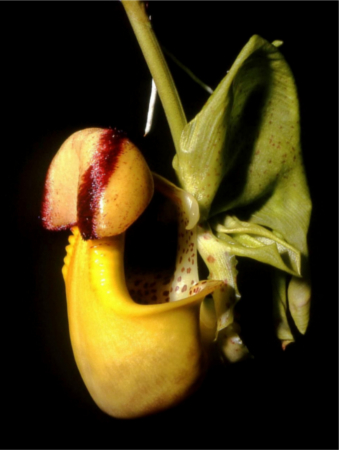- Series:Animals, Plants, Transcript English
Genesis 1:12
“And the earth brought forth grass, and herb yielding seed after his kind, and the tree yielding fruit, whose seed was in itself, after his kind: and God saw that it was good.”
 Coryanthes macrantha, commonly known as the bucket orchid, grows in Mexico and Central and South America. The pretty, but unassuming, flowers form a little receptacle or bucket, into which the flower drips a strongly scented fluid. This scent attracts the flower’s only pollinator – the beautiful, green, male orchid bee.
Coryanthes macrantha, commonly known as the bucket orchid, grows in Mexico and Central and South America. The pretty, but unassuming, flowers form a little receptacle or bucket, into which the flower drips a strongly scented fluid. This scent attracts the flower’s only pollinator – the beautiful, green, male orchid bee.
On entering the flower, the bee falls into the bucket trap. But it is not the orchid’s purpose to kill the bee. The bee soon finds a little step, and an escape hatch. However, the flower grips the bee and glues two pollen sacks to its back. When the glue is dry, the flower releases the unharmed bee, which makes its escape.
The pollen sacks and the scent are essential to the bee’s own courtship ritual with female bees. It is the orchid’s scent which is attractive to the female.
If a male bee which already has pollen sacks on its back enters the bucket orchid, then the flower simply snatches the sacks off the back of the bee and releases it immediately, thus completing the flower’s rather complicated pollination process.
Most articles about the orchid and the bee refer to their co-evolution, which has left them totally dependent on each other. Yet, no partially evolved orchid could survive.
An orchid whose escape hatch was too big would release the bee without the pollen, while too small a hatch would trap the bee until it died. Either way, a partially evolved orchid could not pollinate. So-called co-evolution is clearly impossible. Author: Paul F. Taylor
Prayer: We are amazed by the wisdom and interdependence of the many things that You have created, our Lord and God, and we praise Your great and holy Name. Amen.
Ref: Encyclopedia Britannica, < https://www.britannica.com/plant/bucket-orchid >, accessed 8/31/2018. Image: Wikimedia Commons, license: CC BY-SA 3.0.
